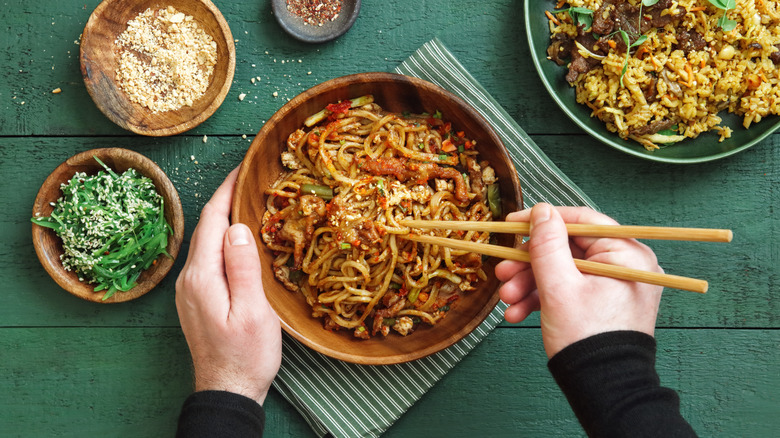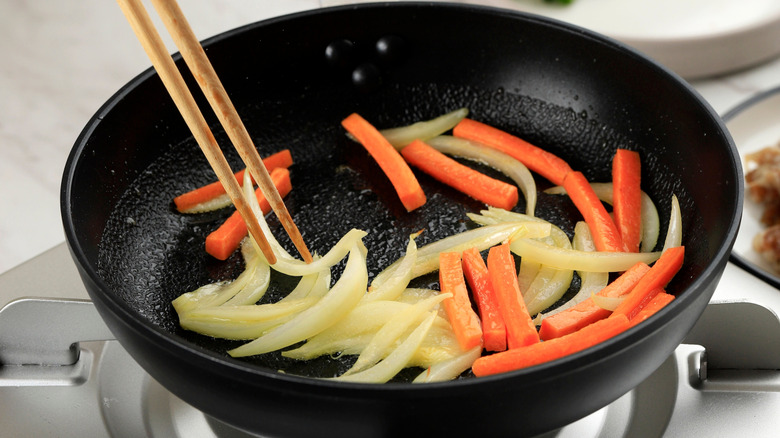Why Wood Is Actually The Best Material For Novice Chopstick Users
If you go out to eat at a sushi place or order Chinese takeout, you're likely supplied with a set of disposable chopsticks. Chopsticks are a traditional instrument to cook with and eat with in many Asian countries, and have been for thousands of years. Since they are now widely used across the United States as well, you've almost certainly come across restaurants that give you chopsticks as primary eating utensils. However, when it comes to how to hold chopsticks properly, it can feel quite uncomfortable to novices who didn't grow up learning the technique.
This is where wooden chopsticks are particularly useful, because they are rougher than other materials. The wood grips the food you reach for more effectively and makes the chopsticks less likely to rotate in your hand so they don't slip out of position. Not to mention, wood can stand up against high temperatures without leeching strange tastes into the food. So, when it comes to the best material for newbie chopstick users, nothing beats wood, particularly unfinished wood.
How wood stacks up against other materials
You should start with simple, undecorated wooden chopsticks. This way, they have a good grip area and don't flake off paint. Disposable wood chopsticks are actually great starter instruments because they are basically free with any order of Asian delivery food. You can even reuse them! Once you've leveled up a little, however, you can find nicer-looking ones made from hinoki cyprus or ebony.
Other materials do have their upsides, though. Metal chopsticks can be easy to clean, and plastic ones are better for certain rice dishes. Melamine is heat-safe and durable longterm. You may even be able to find some sets with assistance devices at the ends meant to make eating with them easier. However, wood is the best for picking up food and staying in the proper position in your hand. Metal can feel slippery and heavy, and melamine is more likely to rotate in your grasp. They're fine for experienced chopstick users, but they could quickly become frustrating for beginners.
Of course, wood does have one major downfall: It's difficult to clean. You can't simply pop it into the dishwasher, because wood can warp, discolor, and degrade if left to soak in water. The shape of chopsticks does make them fairly simple to clean by hand, but for some, it's just an extra hassle. There are some dishwasher-safe wooden chopsticks on the market, so check for those when looking for a longterm pair.
Wooden chopsticks are for more than just eating
The more you use chopsticks, the better you get with them, so starting with wood ones can give you a boost toward chopstick proficiency. For one thing, you can use them when cooking. Specialized wooden cooking chopsticks do tend to be longer and sturdier than the ones you eat with, but you can also use the eating variety for cooking.
If you find it's hard to pick up just one noodle to check if it's done when boiling, a chopstick can help you get a single one more easily. They work similarly to tongs when you need to flip small items or ones placed close together. In many Asian countries, chopsticks are used to beat eggs or mix stir-fry, and wooden ones don't scratch up your nonstick pans. These techniques generally take less dexterity than eating, so they can be a good starting point to practice as you pursue chopstick mastery.
If you're not comfortable enough holding them to stir or flip things in a pan, you can still use wooden chopsticks to test if oil is hot enough to fry with. Simply dip one end into the oil, and if little bubbles come off of it, your oil is ready. So, even if you would prefer eating with metal chopsticks that are machine-washable, or not eating with chopsticks at all, having some wooden chopsticks around can still be helpful.


